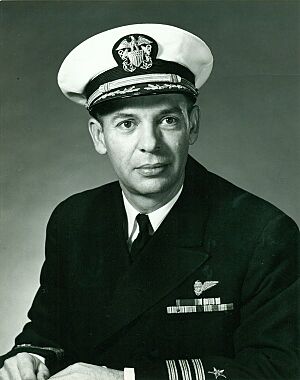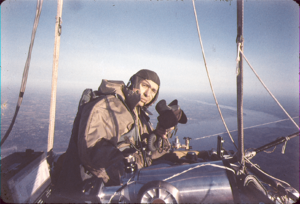Malcolm Ross (balloonist) facts for kids
Quick facts for kids
Malcolm David Ross
|
|
|---|---|

Malcolm Ross
|
|
| Born | October 15, 1919 Momence, Illinois, U.S.
|
| Died | October 8, 1985 (aged 65) Birmingham, Michigan, U.S.
|
| Resting place | Arlington National Cemetery |
| Education | 1941 BS in physics (Purdue), 1944 postgraduate certificate in meteorology (Univ of Chicago) |
| Occupation | Atmospheric Physicist |
| Employer | Office of Naval Research, Washington, D.C. |
| Known for | Scientific and record-breaking manned balloon flights |
| Title | Captain (USNR) |
| Spouse(s) | Marjorie Martin |
Malcolm David Ross (born October 15, 1919 – died October 8, 1985) was a captain in the U.S. Naval Reserve. He was also a scientist who studied the atmosphere and a balloonist. He set many records for how high he flew and for scientific discoveries. By 1961, he had spent over 100 hours flying in gas balloons. With Lieutenant Commander Victor A. Prather of the U.S. Navy, he set the world altitude record for a balloon flight with people inside.
Contents
Malcolm Ross's Early Life and Career
Malcolm Ross was born in Momence, Illinois, on October 15, 1919. He grew up mostly in West Lafayette, Indiana. In 1936, he graduated from Linden High School. He then went to Purdue University on a scholarship. He first studied civil engineering, but later changed to physics. He graduated from Purdue in June 1941 with a degree in physics. After college, he married his high school sweetheart, Marjorie Martin. He worked in radio broadcasting in different cities.
In January 1943, Ross joined the United States Naval Reserve. The Navy sent him to the University of Chicago to study physics and meteorology (the study of weather). He finished this training in June 1944.
Ross served in World War II as an officer. He worked on the USS Saratoga, an aircraft carrier. He helped with weather information for missions over Tokyo and Iwo Jima in the Pacific Ocean theater of World War II. He earned a campaign star for his service.
After the war, Ross started an advertising business in Pasadena, California. His wife, Marjorie, helped him run the business. In 1950, he was called back to active duty for the Korean War. He first taught about radiation defense in San Francisco. Later, in 1951, the Navy moved him to Minneapolis. He worked as a contact officer for the Office of Naval Research.
High-Altitude Balloon Projects
The Navy had a program called Project Skyhook, which used unmanned balloons. This program was based in Minneapolis. In 1953, Ross moved to Washington, D.C., to direct balloon projects for the Office of Naval Research (ONR). In this role, he led projects that used high-altitude balloons. These balloons collected data on cosmic rays and weather in the upper atmosphere. He also helped with an expedition to the Galápagos Islands for similar research.
Ross started the Navy's manned balloon program, Project Strato-Lab, in 1954. This program used new plastic balloons that could fly very high. Ross became the first military officer to be a licensed free balloon pilot based on his experience with these plastic balloons. He later worked as a physicist for the ONR, focusing on the physics of the upper atmosphere. He took part in many Strato-Lab flights, spending over 100 hours observing the stratosphere with other scientists. By the time of his record-setting flight in 1961, Malcolm Ross was a Commander in the Naval Reserve.
Ross received several awards for his scientific work and flights. In 1957, he got the Navy League's Rear Admiral William S. Parsons Award. He also received the Navy Meritorious Civilian Service Award. In 1958, he and Lieutenant Commander Morton Lee Lewis won the Harmon International Trophy for their record flight in 1956. He won the Harmon Trophy again in 1962 with Victor Prather for their 1961 record flight. After 1961, Ross stopped flying balloons. However, he continued to support using balloons for scientific research because they were less expensive.
Ross retired from the U.S. Naval Reserve as a captain on July 1, 1973. After leaving the Office of Naval Research, he worked in space research at General Motors. Later, he became an executive at a stock brokerage company called Merrill Lynch.
Malcolm Ross died at his home in Birmingham, Michigan. He is buried with his wife, Marjorie, at Arlington National Cemetery.
Malcolm Ross's Balloon Flights
Here are some of Malcolm Ross's important balloon flights:
| Date | Altitude | Comments |
|---|---|---|
| August 10, 1956 | 40,000 feet (12,000 m) | With Lieutenant Commander M. L. Lewis, Ross made the first manned flight into the stratosphere using an Office of Naval Research Strato-Lab balloon. The goal was to study airplane vapor trails. |
| November 8, 1956 | 76,000 feet (23,000 m) | Ross and Lieutenant Commander M. L. Lewis set a world altitude record in the plastic Strato-Lab High I balloon. They broke a 21-year-old record. They took off from South Dakota's Stratobowl. The flight lasted over four hours and covered about 175 miles (282 km). The purpose was to gather weather, cosmic ray, and other scientific data. This was the first time the sky overhead was seen as black from a balloon. It also showed that people could safely fly in the stratosphere using light, inexpensive plastic balloons. For this flight, they received the 1956 Harmon Trophy. |
| June 27, 1957 | With atmospheric physicist Charles B. Moore, Ross flew a Strato-Lab balloon into a cumulus cloud from Mount Withington, New Mexico. They wanted to study the inside of a thunderstorm. | |
| October 18, 1957 | 85,700 feet (26,100 m) | Ross and Lieutenant Commander M. L. Lewis made a 10-hour flight into the stratosphere. They carried equipment to photograph Sputnik, the Soviet space satellite, but could not see it. They reached an unofficial two-man altitude record of 85,700 feet (26,100 m) in a Strato-Lab High II balloon. |
| May 6–7, 1958 | 40,000 feet (12,000 m) | With Alfred H. Mikesell, an astronomer, Ross flew in an open gondola (the basket under the balloon). They took off from Minnesota and drifted 325 miles (523 km) in over 11 hours. Alfred Mikesell was the first astronomer to use a telescope from the stratosphere. This was also the first flight where a crew stayed in an open gondola in the stratosphere after sunset. The flight aimed to find out where the atmosphere causes scintillation (the twinkling of starlight). The findings from this flight helped design modern telescopes. A later flight in this project was cancelled after an accident during preflight experiments. |
| July 26–27, 1958 | 82,000 feet (25,000 m) | Ross and Lieutenant Commander M. L. Lewis flew in the Strato-Lab High III gondola. They set a new unofficial record for stratospheric flight duration: 34 hours and 20 minutes. The balloon carried a record load of 5,500 pounds (2,500 kg). The main goal was to test a sealed cabin system. This system was designed to carry a telescope to observe the atmosphere of Venus. During the flight, Ross and Lewis made the first television broadcast from a balloon in the stratosphere. They even broadcast live on NBC, describing their unique experience. |
| August 7, 1959 | 38,000 feet (12,000 m) | With Robert Cooper, Ross flew in an open gondola. They made the first observations of the Sun's corona (its outer atmosphere) from a balloon using a coronagraph. They also tried to measure how sky brightness changed with altitude. |
| November 28–29, 1959 | 81,000 feet (25,000 m) | Ross took Charles B. Moore to perform spectrographic analysis of the planet Venus. This was done with minimal interference from Earth's atmosphere. The flight lasted over 28 hours. Ross and Moore used a telescope and spectrograph to look for water vapor in Venus's atmosphere. They showed that an observatory could be successfully flown high above the ground. |
| May 4, 1961 | 113,740 feet (34.67 km) | With Lieutenant Commander Victor A. Prather, Ross successfully flew the Strato-Lab V balloon into the stratosphere. They set an altitude record of 113,740 feet (34.67 km). Ross and Prather wore the Navy's Mark IV full-pressure suit. The gondola was open to space, but protected by blinds. The balloon was the largest ever launched. The main goal was to test the Navy Mark IV full-pressure suit. This suit was so good that NASA used a changed version for the Project Mercury astronauts. The May 4 flight was the toughest test for the suit. The flight lasted almost 10 hours and covered 140 miles (230 km). As of 2015, this 1961 balloon flight still holds the absolute altitude record for balloonists who return to Earth with their balloon. The flight was a success, but sadly, Victor Prather passed away during the helicopter transfer after landing. For this record flight, President John F. Kennedy presented the Harmon Trophy to the balloonists (Victor Prather's wife accepted for him). |
Awards and Accolades
- In 1956, along with Morton L. Lewis, he was awarded the Harmon Trophy for Aeronauts.
- In 1957, he received the first Rear Admiral William S. Parsons Award for Scientific and Technical Progress from the Navy League of the United States.
- In 1957, he was awarded the Navy Meritorious Civilian Service Award.
- In 1958, he received the Distinguished Flying Cross for his amazing achievement during a dangerous flight into the upper stratosphere on July 26–27, 1958.
- In 1960, he received a Special Award from the American Meteorological Society with Charles B. Moore and, posthumously, Lee Lewis, for their important observations from high-altitude balloons.
- In 1961, he was awarded the Gold Star (which means a second Distinguished Flying Cross) for his bravery and amazing achievement during a balloon flight on May 4, 1961.
- In 1961, he was awarded the Harmon Trophy for Aeronauts with Lt. Cdr. Victor E. Prather (who received it posthumously). President John F. Kennedy presented the award at the White House.
| Awards and achievements | ||
|---|---|---|
| Preceded by |
Harmon Trophy for Aeronauts 1956 |
Succeeded by |
| Preceded by (First Recipient) |
Rear Admiral William S. Parsons Award for Scientific and Technical Progress 1957 |
Succeeded by |
| Preceded by |
Harmon Trophy for Aeronauts 1961 |
Succeeded by |
See also
- Charles B. Moore
- Felix Baumgartner
- Flight altitude record
- Manned balloon altitude records
- Project Manhigh
- Project Skyhook
- Project Strato-Lab
- Victor A. Prather
- Winzen Research
Malcolm Ross Papers
- Malcolm D. Ross Papers including photographs, notes, correspondence, and medical records, are archived at the Smithsonian Institution, National Air and Space Museum.
Records
| Records | ||
|---|---|---|
| Preceded by Captain O. A. Anderson and Captain A. W. Stevens |
Highest Balloon Ascent (23.165 km (76,000 ft)) November 8, 1956 – June 2, 1957 |
Succeeded by Captain Joseph W. Kittinger |
| Preceded by David Simons |
Highest Absolute Altitude for Balloon Flight (34.668 km (113,740 ft)) May 4, 1961 – present |
Succeeded by current record |


